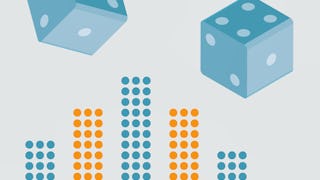Ce cours est le troisième cours d'une spécialisation en 3 parties intitulée "Statistiques et analyse de données appliquées" Le cours est destiné à ceux qui sont familiers avec les statistiques mais qui ne sont pas familiers avec le langage de programmation R.

Acquérir des compétences de haut niveau avec Coursera Plus pour 199 $ (régulièrement 399 $). Économisez maintenant.

Statistiques et analyse de données avec R
Ce cours fait partie de Spécialisation Statistiques et analyse de données appliquées

Instructeur : Charlie Nuttelman
Inclus avec
Expérience recommandée
Ce que vous apprendrez
Utiliser les fonctions statistiques de RStudio pour résoudre des problèmes liés aux distributions de probabilités discrètes et continues.
Créer des modèles simples de régression linéaire, polynomiale et multilinéaire dans RStudio et utiliser ces modèles pour faire des prédictions.
Effectuer des tests d'hypothèse à un et à deux échantillons et créer des intervalles de confiance et de prédiction pour diverses statistiques.
Compétences que vous acquerrez
- Catégorie : structures de données
- Catégorie : Analyse statistique
- Catégorie : Maîtrise des données
- Catégorie : Manipulation de données
- Catégorie : Tracé (graphique)
- Catégorie : Distribution de probabilité
- Catégorie : Analyse de régression
- Catégorie : La programmation en R
- Catégorie : Tidyverse (Package R)
- Catégorie : Tests d'hypothèses statistiques
- Catégorie : Importation/exportation de données
- Catégorie : Inférence statistique
- Catégorie : Méthodes statistiques
- Catégorie : Statistiques
- Catégorie : Statistiques descriptives
- Catégorie : Analyse des Données
- Catégorie : Modélisation statistique
Détails à connaître

Ajouter à votre profil LinkedIn
6 devoirs
Découvrez comment les employés des entreprises prestigieuses maîtrisent des compétences recherchées

Élaborez votre expertise du sujet
- Apprenez de nouveaux concepts auprès d'experts du secteur
- Acquérez une compréhension de base d'un sujet ou d'un outil
- Développez des compétences professionnelles avec des projets pratiques
- Obtenez un certificat professionnel partageable

Il y a 6 modules dans ce cours
Bienvenue à "Statistiques et Analyse des données avec R" ! Au cours de cette semaine, R et RStudio vous seront présentés et vous apprendrez à installer et à naviguer dans RStudio. Vous apprendrez ensuite à effectuer des calculs de base, à utiliser des fichiers scripts, à créer et à travailler avec des vecteurs et des matrices, ainsi qu'à installer et à charger des modules complémentaires. Enfin, vous apprendrez tout sur les cadres de données et les tableaux, comment importer des données à partir de fichiers externes (fichiers .xlsx, .csv et .txt) et comment travailler avec des fonctions définies par l'utilisateur et des fonctions intégrées. Lorsque vous serez prêt, vous devrez réussir le quiz noté de la semaine 1 afin d'accéder aux fichiers de démarrage et à l'antisèche de la semaine 2. Vous aurez besoin d'accéder à ces éléments pour compléter le module 2. Vous devez également réussir le devoir 1, qui compte pour la note finale du cours.
Inclus
14 vidéos4 lectures1 devoir1 devoir de programmation2 sujets de discussion
Au cours de la semaine 2, vous apprendrez à calculer les statistiques descriptives courantes en R, à calculer les statistiques conditionnelles et à présenter les données sous forme de graphiques (diagrammes de dispersion, diagrammes en colonnes et diagrammes circulaires). Vous apprendrez également à créer des diagrammes en boîte et des diagrammes de probabilité en R et à analyser la normalité des données à l'aide de la statistique d'Anderson-Darling. La semaine 2 comprend 9 screencasts avec de nombreuses questions dans la vidéo pour tester votre compréhension du matériel et vous aider à apprendre. La semaine se termine par un devoir pratique 2, que vous réaliserez dans un Bloc-notes Carnet R dans le langage de programmation R et qui compte pour votre note finale dans le cours. Lorsque vous êtes prêt, vous devez réussir le quiz noté de la semaine 2 afin d'accéder aux fichiers de démarrage et à l'antisèche de la semaine 3. Vous aurez besoin d'accéder à ces éléments pour compléter le module 3. Nous vous souhaitons bonne chance cette semaine ! Comme toujours, si vous avez des questions ou des problèmes, veuillez lancer un fil de discussion et moi-même ou quelqu'un d'autre interviendra pour vous aider.
Inclus
9 vidéos1 lecture1 devoir1 devoir de programmation1 sujet de discussion
Au cours de la semaine 3, vous apprendrez tout sur les probabilités et les règles de comptage dans R, notamment comment calculer les combinaisons et les permutations, comment calculer les probabilités associées aux distributions de probabilités discrètes courantes (distributions binomiale, géométrique, binomiale négative, hypergéométrique et de Poisson) et comment calculer les probabilités associées aux distributions de probabilités continues courantes (distributions uniforme, normale, T, chi-deux et F) dans R. Vous effectuerez également des calculs de distribution normale inverse et leurs valeurs z associées (normalisation). La semaine 3 comporte 14 screencasts avec de nombreuses questions en vidéo pour tester votre compréhension de la matière et vous aider à apprendre. La semaine se termine par l'affectation 3 dans laquelle vous effectuerez plusieurs calculs dans un Bloc-notes. L'affectation 3 compte pour votre note finale dans le cours. Lorsque vous êtes prêt, vous devez réussir le quiz noté de la semaine 3 afin d'accéder aux fichiers de démarrage et à l'antisèche de la semaine 4. Vous aurez besoin d'accéder à ces éléments pour compléter le module 4. Nous vous souhaitons bonne chance cette semaine ! Comme toujours, si vous avez des questions ou des problèmes, veuillez lancer un fil de discussion et moi-même ou quelqu'un d'autre interviendra pour vous aider.
Inclus
16 vidéos1 lecture1 devoir1 devoir de programmation1 sujet de discussion
Au cours de la semaine 4, vous apprendrez à calculer des statistiques à un échantillon dans R. Vous commencerez la semaine en apprenant à calculer des intervalles de confiance et de prédiction sur la moyenne, la variance et la proportion binomiale. Ensuite, vous apprendrez à effectuer des Tests d'hypothèse sur la moyenne, la variance et une proportion binomiale. Vous apprendrez également à calculer la puissance et la probabilité d'une erreur de type II dans R, ce qui est lié à des considérations de taille d'échantillon, que vous explorerez également. La semaine 4 comporte 10 screencasts avec de nombreuses questions dans la vidéo pour tester votre compréhension de la matière et vous aider à apprendre. Je vous encourage à télécharger et à utiliser l'antisèche de la semaine 4 (pour ceux qui achètent un certificat de cours) car elle vous aidera à distiller les concepts difficiles et les fonctions R qui se trouvent dans le matériel de cette semaine. La semaine 4 se termine par l'affectation 4, que vous réaliserez dans le langage de programmation R dans un Bloc-notes et qui compte pour votre note finale dans le cours. Lorsque vous serez prêt, vous devrez réussir le quiz noté de la semaine 4 afin d'accéder aux fichiers de démarrage et à l'antisèche de la semaine 5. Vous aurez besoin d'accéder à ces éléments pour compléter le module 5. Le Quiz 4 vous demande d'effectuer des calculs statistiques en R, alors préparez-vous en conséquence.
Inclus
12 vidéos1 lecture1 devoir1 devoir de programmation1 sujet de discussion
Au cours de la semaine 5, vous apprendrez tout sur les comparaisons à deux échantillons. Vous calculerez les intervalles de confiance liés aux tests d'hypothèse impliquant la comparaison de moyennes, la comparaison de variances et la comparaison de proportions binomiales. Le type de test effectué dépend du fait que la variance est connue ou inconnue, ce que vous explorerez également. La semaine 5 comporte 7 screencasts avec de nombreuses questions dans la vidéo pour tester votre compréhension du matériel et vous aider à apprendre. La semaine se termine par l'exercice 5. Lorsque vous serez prêt, vous devrez réussir le Quiz 5 afin de poursuivre le cours. Vous voudrez également porter une attention particulière à l'antisèche de la semaine 5 (disponible pour les apprenants qui achètent un certificat de cours) car elle vous servira de référence pour l'exercice 5 et l'antisèche 5. Lorsque vous serez prêt, vous devrez réussir l'antisèche de la semaine 5 afin d'accéder aux fichiers de démarrage et à l'antisèche de la semaine 6. Vous aurez besoin d'accéder à ces éléments pour compléter le module 6. Le Quiz 5 vous demande d'effectuer des calculs statistiques en R, alors préparez-vous en conséquence.
Inclus
7 vidéos1 lecture1 devoir1 devoir de programmation1 sujet de discussion
Au cours de la semaine 6, vous apprendrez à créer des modèles de régression linéaire, polynomiale et multilinéaire simples, qui sont essentiellement des relations mathématiques entre des variables d'entrée (variables régressives) et une variable de sortie (réponse). Vous apprendrez à calculer des intervalles de confiance et à effectuer des tests d'hypothèse sur les paramètres du modèle et vous apprendrez à sélectionner le meilleur modèle de régression possible parmi plusieurs modèles candidats à l'aide de l'élimination à rebours. Enfin, vous apprendrez à effectuer une analyse de variance (ANOVA) lorsque vous avez plus de deux groupes à comparer. La semaine 6 comprend 9 screencasts avec de nombreuses questions dans la vidéo pour tester votre compréhension du matériel et vous aider à apprendre. La semaine se termine par l'exercice 6. Lorsque vous serez prêt, vous devrez réussir le Quiz 6 afin de poursuivre le cours. Vous devrez également prêter attention à l'antisèche de la semaine 6 (disponible pour les apprenants qui achètent un certificat de cours), car elle vous servira de référence pour le devoir 6 et le quiz 6. L'interrogation 6 vous demande d'effectuer des calculs statistiques en R, alors assurez-vous de vous préparer en conséquence. Une fois que vous aurez terminé la semaine 6, vous aurez terminé le cours !
Inclus
9 vidéos1 devoir1 devoir de programmation1 sujet de discussion
Obtenez un certificat professionnel
Ajoutez ce titre à votre profil LinkedIn, à votre curriculum vitae ou à votre CV. Partagez-le sur les médias sociaux et dans votre évaluation des performances.
Instructeur

Offert par
En savoir plus sur Probabilités et Statistiques
 Statut : Prévisualisation
Statut : PrévisualisationO.P. Jindal Global University
 Statut : Essai gratuit
Statut : Essai gratuit Statut : Essai gratuit
Statut : Essai gratuitDuke University
Pour quelles raisons les étudiants sur Coursera nous choisissent-ils pour leur carrière ?




Foire Aux Questions
Pour accéder aux supports de cours, aux devoirs et pour obtenir un certificat, vous devez acheter l'expérience de certificat lorsque vous vous inscrivez à un cours. Vous pouvez essayer un essai gratuit ou demander une aide financière. Le cours peut proposer l'option "Cours complet, pas de certificat". Cette option vous permet de consulter tous les supports de cours, de soumettre les évaluations requises et d'obtenir une note finale. Cela signifie également que vous ne pourrez pas acheter un certificat d'expérience.
Lorsque vous vous inscrivez au cours, vous avez accès à tous les cours de la spécialisation et vous obtenez un certificat lorsque vous terminez le travail. Votre certificat électronique sera ajouté à votre page Réalisations - de là, vous pouvez imprimer votre certificat ou l'ajouter à votre profil LinkedIn.
Oui, pour certains programmes de formation, vous pouvez demander une aide financière ou une bourse si vous n'avez pas les moyens de payer les frais d'inscription. Si une aide financière ou une bourse est disponible pour votre programme de formation, vous trouverez un lien de demande sur la page de description.
Plus de questions
Aide financière disponible,






